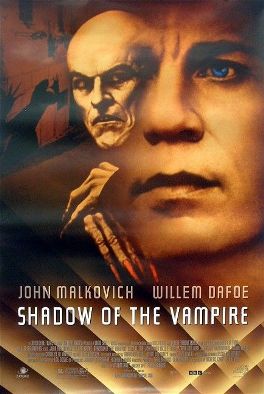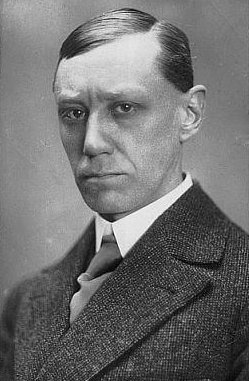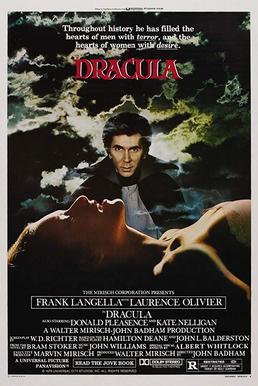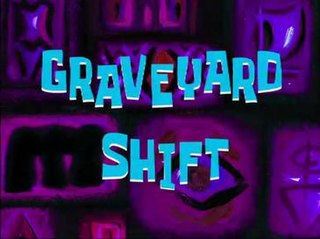
Nosferatu: A Symphony of Horror is a 1922 silent German Expressionist vampire film directed by F. W. Murnau from a screenplay by Henrik Galeen. It stars Max Schreck as Count Orlok, a vampire who preys on the wife of his estate agent and brings the plague to their town.

Shadow of the Vampire is a 2000 independent period vampire Gothic mystery film directed by E. Elias Merhige and written by Steven Katz. The film stars John Malkovich and Willem Dafoe. It is a fictionalized account of the making of the classic vampire film Nosferatu, eine Symphonie des Grauens, directed by F. W. Murnau, during which the film crew begin to have disturbing suspicions about their lead actor.

Friedrich Gustav Maximilian Schreck, known professionally as Max Schreck, was a German actor, best known for his lead role as the vampire Count Orlok in the film Nosferatu (1922).

Professor Abraham Van Helsing is a fictional character from the 1897 gothic horror novel Dracula written by Bram Stoker. Van Helsing is a Dutch polymath doctor with a wide range of interests and accomplishments, partly attested by the string of letters that follows his name: "MD, D.Ph., D.Litt., etc.", indicating a wealth of experience, education and expertise. He is a doctor, professor, lawyer, philosopher, scientist, and metaphysician. The character is best known through many adaptations of the story as a vampire slayer, monster hunter and the arch-nemesis of Count Dracula, and the prototypical and the archetypal parapsychologist in subsequent works of paranormal fiction. Some later works tell new stories about Van Helsing, while others, such as Dracula (2020) and I Woke Up a Vampire (2023) have characters that are his descendants.

R. M. Renfield is a fictional character who appears in Bram Stoker's 1897 Gothic horror novel Dracula. He is Count Dracula's deranged, fanatically devoted servant and familiar, helping him in his plan to turn Mina Harker into a vampire in return for a continuous supply of insects to consume and the promise of immortality. Throughout the novel, he resides in an asylum, where he is treated by Dr. John Seward.

Dracula is a 1931 American pre-Code supernatural horror film directed and co-produced by Tod Browning from a screenplay written by Garrett Fort and starring Bela Lugosi in the title role. It is based on the 1924 stage play Dracula by Hamilton Deane and John L. Balderston, which in turn is adapted from the 1897 novel Dracula by Bram Stoker. Lugosi portrays Count Dracula, a vampire who emigrates from Transylvania to England and preys upon the blood of living victims, including a young man's fiancée.

Dracula is a 1979 gothic horror film directed by John Badham. The film starred Frank Langella in the title role as well as Laurence Olivier, Donald Pleasence and Kate Nelligan.

Wilhelmina "Mina" Harker is a fictional character and the main female character in Bram Stoker's 1897 Gothic horror novel Dracula.

Vampire films have been a staple in world cinema since the era of silent films, so much so that the depiction of vampires in popular culture is strongly based upon their depiction in films throughout the years. The most popular cinematic adaptation of vampire fiction has been from Bram Stoker's 1897 novel Dracula, with over 170 versions to date. Running a distant second are adaptations of the 1872 novel Carmilla by Sheridan Le Fanu.

Nosferatu the Vampyre is a 1979 gothic horror film directed and written by Werner Herzog. The film serves as both a remake of the 1922 film Nosferatu and an adaptation of Bram Stoker's 1897 novel Dracula. Herzog’s film is set in 19th-century Wismar, Germany and Transylvania. The picture stars Klaus Kinski as Count Dracula, Isabelle Adjani as Lucy Harker, Bruno Ganz as Jonathan Harker, and French artist-writer Roland Topor as Renfield. There are two different versions of the film, one in which the actors speak English, and one in which they speak German.

Vampires are frequently represented in popular culture across various forms of media, including appearances in ballet, films, literature, music, opera, theatre, paintings, and video games.

Nosferatu: Plague of Terror, later published under the title Nosferatu: Sovereign of Terror, is a four-part comic series released by American publisher Millennium Publications from 1991 to 1992. Conceived as both a prequel and sequel to F.W. Murnau's silent film Nosferatu, it was written by Mark Ellis, designed by Melissa Martin, with art provided by Rik Levins, Richard Pace, and Frank Turner.

Vampire in Venice, also known as Prince of the Night and Nosferatu in Venice is a 1988 Italian supernatural horror film directed by Augusto Caminito and an uncredited Klaus Kinski, and starring Kinski, Christopher Plummer, Donald Pleasence, and Barbara De Rossi. The story follows Professor Paris Catalano (Plummer), who travels to Venice following the trail of the last known appearance of Nosferatu (Kinski), who was seen at Carnival in 1786. Catalano learns through a séance that the vampire is seeking eternal death, and tries to put an end to its existence once and for all.
Boo! is a 1932 American Pre-Code comedy horror short film by Universal Pictures, directed and written by Albert DeMond. Boo! contains clips of horror films Nosferatu (1922), The Cat Creeps (1930), and Frankenstein (1931), mocking them thoroughly.

Greta Schröder was a German actress. She is best known for the role of Ellen Hutter, Thomas Hutter's wife and the cause of Count Orlok's destruction in Nosferatu (1922). In the fictionalized 2000 film Shadow of the Vampire, she is portrayed as having been a famous actress during the making of Nosferatu, but in fact she was little known. The bulk of her career was during the 1920s, and she continued to act well into the 1950s, but by the 1930s her roles had diminished to only occasional appearances. Following a failed marriage with struggling actor Ernst Matray, she was married to actor and film director Paul Wegener.

"Graveyard Shift" is the first part of the 16th episode of the second season, and the 36th episode overall, of the American animated television series SpongeBob SquarePants. The episode was written by Mr. Lawrence, Jay Lender and Dan Povenmire, and the animation was directed by Sean Dempsey. Lender and Povenmire also served as storyboard directors. The episode was copyrighted in 2001 and aired on Nickelodeon in the United States on September 6, 2002.

Bill Istvan Günther Skarsgård is a Swedish actor. He is known for portraying Pennywise in the horror films It (2017) and It Chapter Two (2019). Other horror appearances were in the series Hemlock Grove (2013–2015) and Castle Rock (2018–2019) and the films Barbarian (2022) and Nosferatu (2024).

Thomas Hutter is a fictional character and the main protagonist in the silent expressionist horror film Nosferatu, eine Symphonie des Grauens (1922) and other films based on it.

Nosferatu is a 2024 American gothic horror film written and directed by Robert Eggers. It is a remake of F. W. Murnau's 1922 film Nosferatu: A Symphony of Horror, itself based on Bram Stoker's 1897 novel Dracula. The film stars Bill Skarsgård as Count Orlok, while Nicholas Hoult and Lily-Rose Depp star as Thomas and Ellen Hutter. The supporting cast includes Aaron Taylor-Johnson, Emma Corrin, Ralph Ineson, Simon McBurney, and Willem Dafoe.
Nosferatu: A Symphony of Horror is a 2023 American horror film directed by David Lee Fisher, a remake of the 1922 silent film Nosferatu. It premiered at the Emagine Theater in Novi, Michigan on November 11, 2023.




















